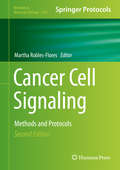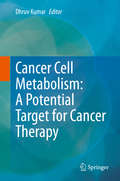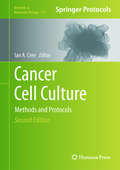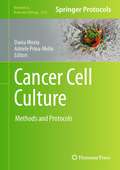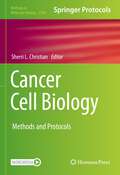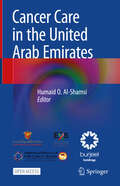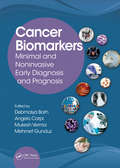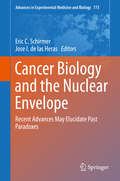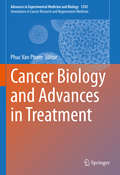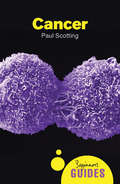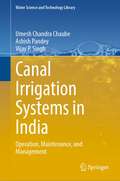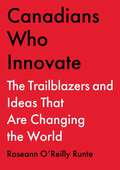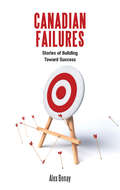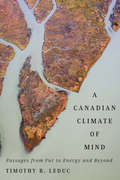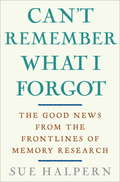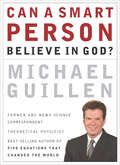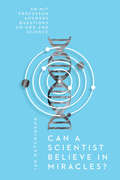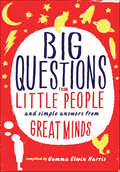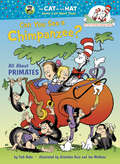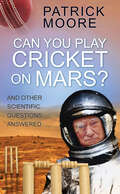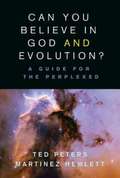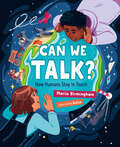- Table View
- List View
Cancer Cell Signaling: Methods and Protocols (Methods in Molecular Biology #1165)
by Martha Robles-FloresCancer Cell Signaling: Methods and Protocols, Second Edition brings together the most recent advances in cancer cell signaling knowledge along with recent progress in the development of novel strategies and experimental cell models to study human cancer. Opening with a section on targeting cancer cell metabolism as an anticancer strategy, this detailed volume continues with parts describing protocols to study epigenetic control of cancer, protocols to study cancer metastasis, as well as two new techniques for cancer study Written for the highly successful Methods in Molecular Biology series, chapters include introductions for their respective topics, lists of the necessary materials and reagents, step-by-step, readily reproducible laboratory protocols and tips on troubleshooting and avoiding known pitfalls. Authoritative and timely, Cancer Cell Signaling: Methods and Protocols, Second Edition is an ideal guide to the techniques that will aid researchers in exploiting our current knowledge in order to make a profound impact in cancer prevention and treatment.
Cancer Cell Metabolism: A Potential Target for Cancer Therapy
by Dhruv KumarThis book illustrates various aspects of cancer cell metabolism, including metabolic regulation in solid tumours vs. non-solid tumours, the molecular pathways involved in its metabolism, and the role of the tumour microenvironment in the regulation of cancer cell metabolism. It summarizes the complexity of cancer cell metabolism in terms of the switch from anaerobic to aerobic glycolysis and how mitochondrial damage promotes aerobic glycolysis in cancer cells. The respective chapters provide the latest information on the metabolic remodelling of cancer cells and elucidate the important role of the signalling pathways in reprogramming of cancer cell metabolism. In addition, the book highlights the role of autophagy in cancer cell metabolism, and how metabolic crosstalk between cancer cells and cancer-associated fibroblasts promotes cancer cell progression. In closing, it summarizes recent advancements in drug development through targeting cancer metabolism.
Cancer Cell Culture: Methods and Protocols (Methods in Molecular Biology #731)
by Ian A. CreeWith many recent advances, cancer cell culture research is more important than ever before. This timely edition of Cancer Cell Culture: Methods and Protocols covers the basic concepts of cancer cell biology and culture while expanding upon the recent shift in cell culture methods from the generation of new cell lines to the use of primary cells. There are methods to characterize and authenticate cell lines, to isolate and develop specific types of cancer cells, and to develop new cell line models. Functional assays are provided for the evaluation of clonogenicity, cell proliferation, apoptosis, adhesion, migration, invasion, senescence, angiogenesis, and cell cycle parameters. Other methods permit the modification of cells for transfection, drug resistance, immortalization, and transfer in vivo, the co-culture of different cell types, and the detection and treatment of contamination. In this new edition, specific emphasis is placed on safe working practice for both cells and laboratory researchers. These chapters contain the information critical to success - only by good practice and quality control will the results of cancer cell culture improve. Written in the successful Methods in Molecular BiologyTM series format, chapters include introductions to their respective topics, lists of the necessary materials and reagents, step-by-step, readily reproducible protocols, and notes on troubleshooting and avoiding known pitfalls. Authoritative and accessible, Cancer Cell Culture: Methods and Protocols serves as a practical guide for scientists of all backgrounds and aims to convey the appropriate sense of fascination associated with this research field.
Cancer Cell Culture: Methods and Protocols (Methods in Molecular Biology #2645)
by Dania Movia Adriele Prina-MelloThis volume explores the latest collection of cell models that are used in preclinical cancer research, and covers both two-dimensional and three-dimensional culturing techniques. The chapters in this book are divided into two parts. Part One discusses two-dimensional cancer cell culture, cell models at the Air-Liquid Interface, and the latest advancements in three-dimensional complex spheroid models and dedicated disease animal models. Part Two contains technical chapters that illustrate step-by-step methodologies for specific cancer cell culture methods. The methods discussed range from the generation of isogenic cancer cell lines, the use of serum-free growth conditions, and three-dimensional cell cultures and their specific assays for the efficacy assessment of new anticancer therapies. Written in the highly successful Methods in Molecular Biology series format, chapters include introductions to their respective topics, lists of the necessary materials and reagents, step-by-step, readily reproducible laboratory protocols, and tips on troubleshooting and avoiding known pitfalls.Cutting-edge and comprehensive, Cancer Cell Culture: Methods and Protocols is a valuable tool to help researchers involved in this important field to further improve or advance their models for cancer research.
Cancer Cell Biology: Methods and Protocols (Methods in Molecular Biology #2508)
by Sherri L. ChristianThis volume provides detailed methods on the mechanisms of underlying cancer cell biology. Chapters guide readers through techniques for culturing cancer cell lines, xenografts, cryopreservation of tumor cells, analyzing the co-culture of breast cancer cells, protein secretion by ELISA, flow cytometry-based, multi-parametric immunofluorescence analysis, protein expression by western blot, analysis of surface protein levels, protein recycling by biotinylation assay, and proteomics analysis by liquid chromatography-mass spectrometry. Written in the format of the highly successful Methods in Molecular Biology series, each chapter includes an introduction to the topic, lists necessary materials and reagents, includes tips on troubleshooting and known pitfalls, and step-by-step, readily reproducible protocols. Authoritative and cutting-edge, Cancer Cell Biology: Methods and Protocols aims to provide a comprehensive set of tools for the analysis of cancer cell biology in the lab.
Cancer Care in the United Arab Emirates
by Humaid O. Al-ShamsiThis open access book is an unprecedented and comprehensive book that delves deeply into the landscape of cancer care in the United Arab Emirates (UAE). This ground-breaking book is set to become a go-to resource for those interested in gaining an in-depth understanding of the status quo of cancer care across the seven emirates. The book, edited by Prof. Humaid O. Al- Shamsi, a leading oncologist in the region and the President of the Emirates Oncology Society, embarks on a compelling journey by meticulously examining the evolving cancer policies, treatment modalities, and innovative approaches while celebrating notable success stories. At the same time, it sheds light on the persistent challenges and unmet needs that continue to impact cancer care in the UAE. Authored by a distinguished group of experts hailing from various sectors within the UAE, the book brings together perspectives from oncology specialists, researchers, healthcare policymakers, patient advocates, and other key stakeholders involved in patient management. It covers a diverse range of topics crucial to cancer care, including early detection, diagnosis, treatment options, supportive care services, survivorship, palliative care, and ongoing research initiatives. In addition to addressing the general aspects of cancer care, this pioneering book focuses on the unique factors and challenges specific to the UAE. It explores the impact of cultural and social factors, healthcare infrastructure, regulatory frameworks, and the integration of technological advancements in cancer management. The book also examines the role of patient support organizations, patient empowerment, and community engagement in tackling the cancer burden. Each chapter in "Cancer Care in the UAE" offers valuable insights into the challenges faced by different disciplines involved in cancer care and provides a roadmap for transformative change. By presenting an overarching vision and strategic outlook for the next generation, the book serves as a catalyst for positive change in cancer care across the UAE. Endorsed by prestigious organizations such as the Emirates Oncology Society and the Emirates Medical Association, "Cancer Care in the UAE" stands as a testament to its credibility and relevance. This comprehensive book will undoubtedly contribute significantly to enhancing cancer care, fostering collaboration among stakeholders, and ultimately improving outcomes for individuals affected by cancer in the UAE and wider region.
Cancer Biomarkers: Minimal and Noninvasive Early Diagnosis and Prognosis
by Mukesh Verma Debmalya Barh Mehmet Gunduz Angelo CarpiGleaning information from more than 100 experts in the field of cancer diagnosis, prognosis, and therapy worldwide, Cancer Biomarkers: Non-Invasive Early Diagnosis and Prognosis determines the significance of clinical validation approaches for several markers. This book examines the use of noninvasive or minimally invasive molecular cancer m
Cancer Biology and the Nuclear Envelope: Recent Advances May Elucidate Past Paradoxes (Advances in Experimental Medicine and Biology #773)
by Eric C. Schirmer Jose I. de las Heras"Nuclear envelope (NE) defects have been linked to cancer biology since the mid-1800s, but it was not until the last few years that we have begun to understand these historical links and to realize that there are myriad ways that the NE impacts on tumorigenesis. The NE is a complex double membrane system that encloses the genome while providing structural support through the intermediate filament lamin polymer and regulating protein/ mRNA trafficking and signaling between the nucleus and cytoplasm via the nuclear pore complexes (NPCs). These functions already provide some mechanisms for NE influences on cancer biology but work in the past few years has elucidated many others. Lamins and many recently identified NE transmembrane proteins (NETs) have been now shown to function in DNA repair, regulation of cell cycle and signaling, apoptosis, cell migration in metastasis and nuclear architecture and morphology. This volume presents a comprehensive overview of the wide range of functions recently identified for NE proteins and their relevance in cancer biology, providing molecular mechanisms and evidence of their value as prognostic and diagnostic markers and suggesting new avenues for the treatment of cancer. Indeed some of these recent links are already yielding promising therapies, such as the current clinical trial of selective inhibitors of the nuclear export factor exportin in certain types of leukemia, melanoma and kidney cancer. "
Cancer Biology and Advances in Treatment (Advances in Experimental Medicine and Biology #1292)
by Phuc Van PhamThis new series, based on a bi-annual conference and its topics, represents a major contribution to the emerging science of cancer research and regenerative medicine. Each volume brings together some of the most pre-eminent scientists working on cancer biology, cancer treatment, cancer diagnosis, cancer prevention and regenerative medicine to share information on currently ongoing work which will help shape future therapies. These volumes are invaluable resources not only for already active researchers or clinicians but also for those entering these fields, plus those in industry. Cancer Biology and Advances in Treatment is a proceedings volume which reflects papers presented at the 3rd bi-annual Innovations in Regenerative Medicine and Cancer Research conference; taken with its companion volume Tissue Engineering and Regenerative Medicine and Stem Cells: Biology and Engineering it provides a complete overview of the papers from that meeting of international experts.
Cancer
by Paul ScottingCancer is the second biggest killer in the world, but few of us understand how it works or how it is treated. In this illuminating introduction, Paul Scotting explains the science behind the disease and explores why some of us are more likely to develop it than others. Arguing that we're in a new age of understanding that will revolutionize the fight againtst cancer, Scotting maps out the promising future strategies for its prevention, treatment, and cure.
Canal Irrigation Systems in India: Operation, Maintenance, and Management (Water Science and Technology Library #126)
by Vijay P. Singh Ashish Pandey Umesh Chandra ChaubeThe book focuses broadly on the preliminaries of the canal irrigation systems in India with a focus on their operation, maintenance, and management of the canal systems. The chapters in this book are classified under four sections, viz., (i). preliminaries of the canal irrigation systems, (ii) operation of the canal irrigation systems, (iii) maintenance of the canal irrigation systems, and (iv) management of the canal irrigation systems. The preliminaries of the canal irrigation systems include an integrated view of irrigation and agriculture, irrigation management in India: problems, issues, a brief history, and some lessons, irrigation administration, organizational structure for management of irrigated agriculture, and farmers’ participation. The operation of the canal irrigation systems includes the operation of dams and barrages, canal operation, water distribution planning, measurement of flow and sediment in canals, and performance evaluation of the canal irrigation system, use of groundwater in the canal command area. The canal irrigation systems' maintenance includes dams, barrages, related equipment, canals and related structures, field drainage, diagnostic analysis of canal irrigation system, soil and water quality management, soil moisture, and measurement. The management of the canal irrigation systems includes rehabilitation and modernization and a case study on rehabilitation, conjunctive use management, operation, and maintenance budgeting, and financing. The book is expected to be useful for academicians, water practitioners, scientists, water managers, environmentalists, administrators, NGOs, researchers, and students who are actively involved in the operation, maintenance, and management of the canal irrigation system for addressing the challenges being faced in the irrigated agricultural while addressing issues of canal irrigation systems in South East Asia.
Canadians Who Innovate: The Trailblazers and Ideas That Are Changing the World
by Roseann O'Reilly RunteProfiles of some of the most inventive and creative Canadians and the ideas that are making Canada a leading nation in innovation.From saving lives to saving harvests... From discovering ancient diamonds to identifying the first exo-planet... From driverless cars to quantum computers... From Nobel laureates to your next-door neighbor... This book offers uplifting stories of innovative Canadians. Canadians Who Innovate includes two Nobel laureates, an astronaut, extraordinary business leaders, the godfathers of artificial intelligence, and top quantum experts, including the inventor of what may be the next quantum computer. It features profiles of the first director of engineering at Google, who is now working on nuclear fusion; a medical researcher who communicates on TikTok about the efficacy and potential for RNA vaccine technology; and a PhD in nuclear physics who has twice won the Scotiabank Giller Prize. Meet the linguist who works with Indigenous people to make online dictionaries, an internationally consulted specialist on migration, an agri-tech investor, a world specialist on permafrost, and the expert in systems and number theory who has a way to fix health care. And don&’t forget the engineer who grew human cells on apples, a feat that is leading to the creation of replacement organs that do not require donors—not to be confused with the aerospace technology developer who created a tethering system to clean up space debris and a 3-D printer that prints biological tissue. Featuring brilliant thinkers from coast to coast to coast, and others from around the world who now call Canada home, Canadians Who Innovate paints a promising picture of a cleaner, healthier, more innovative future for us all.
Canadian Failures: Stories of Building Toward Success
by Alex BenayThe Hill Times: Best Books of 2017 Successful Canadians write about failure, and how it got them where they are today. What does it mean to fail? To some of the most successful Canadians, it was a rite of passage, a stepping stone to greater things, or even a brilliant source of inspiration. Olympic golds, successful businesses, pioneering medical advances — all came about after a series of missteps and countless attempts. Canadian Failures gathers ten experts from the private, public, and not-for-profit sectors and academia, all of whom have grappled with failures and success throughout their lives. Their powerful argument: that Canada, and Canadians, must be willing to learn from failure if we hope to succeed. With Chapters By … astronaut Robert Thirsk Olympic gold medalist, wrestler Erica Wiebe Chair of OpenText and of the National Research Council, Tom Jenkins co-founder of the Just for Laughs comedy festival, Andy Nulman … and others at the top of their fields.
Canadian Climate of Mind: Passages from Fur to Energy and Beyond
by Timothy B. LeducThe twenty-first century is a period of great environmental and social transformation as climate change increasingly marks lives at levels that are personal, familial, communal, national, and global. A Canadian Climate of Mind presents stories that emerge from the waters, lands, and climate of Canada, and which have the potential to renew a compassionate energy for changing human relations with each other and with our world. The turbulent effects of climate change are popularly discussed in the modern language of scientific knowledge, political policies, economic mechanisms, and technological innovation. While there is much to be learned from these views, Timothy Leduc suggests a more profound call for change by returning to past understandings of the land and climate. He argues that the world is initiating us into a broader and humbler sense of what it is to be human in an interconnected reality. The world is doing this by responding to unsustainable practices such as our devastating reliance on fossil fuels. Weaving together voices from numerous backgrounds and time periods with Indigenous views on present and past environmental challenges, A Canadian Climate of Mind illuminates a world that is being shaken to its core while we hesitate to act.
Canadian Climate of Mind: Passages from Fur to Energy and Beyond
by Timothy B. LeducThe twenty-first century is a period of great environmental and social transformation as climate change increasingly marks lives at levels that are personal, familial, communal, national, and global. A Canadian Climate of Mind presents stories that emerge from the waters, lands, and climate of Canada, and which have the potential to renew a compassionate energy for changing human relations with each other and with our world. The turbulent effects of climate change are popularly discussed in the modern language of scientific knowledge, political policies, economic mechanisms, and technological innovation. While there is much to be learned from these views, Timothy Leduc suggests a more profound call for change by returning to past understandings of the land and climate. He argues that the world is initiating us into a broader and humbler sense of what it is to be human in an interconnected reality. The world is doing this by responding to unsustainable practices such as our devastating reliance on fossil fuels. Weaving together voices from numerous backgrounds and time periods with Indigenous views on present and past environmental challenges, A Canadian Climate of Mind illuminates a world that is being shaken to its core while we hesitate to act.
Can't Remember What I Forgot
by Sue HalpernBehind the Scenes of Cutting-Edge Memory Research When Sue Halpern decided to emulate the first modern scientist of memory, Hermann Ebbinghaus, who experimented on himself, she had no idea that after a day of radioactive testing, her brain would become so “hot” that leaving through the front door of the lab would trigger the alarm. This was not the first time while researchingCan’t Remember What I Forgotthat Halpern had her head examined, nor would it be the last. Like many of us who have had a relative or friend succumb to memory loss, who are getting older, and who are hearing statistics about our own chances of falling victim to dementia, Halpern wanted to find out what the experts really knew, how close science is to a cure, to treatment, to accurate early diagnosis, and, of course, whether the crossword puzzles, sudokus, and ballroom dancing we’ve been told to take up can really keep us lucid or if they're just something to do before the inevitable overtakes us. Sharply observed and deeply informed,Can’t Remember What I Forgotis a book full of vital information and a solid dose of hope.
Can a Smart Person Believe in God?: Five Equations That Changed The World
by Michael GuillenAs Christians, we are often urged to turn away from scientific discovery and rely solely on the Bible as the source of our faith. On the other hand, many people in areas such as science, law, and education insist that Christian faith is lowbrow or unintelligent. But is it possible to reconcile science with what you believe about God? As someone who has grappled with the issues of science and faith in the public eye for more than a decade as a television journalist, Dr. Michael Guillen believes it is possible. In fact, by embracing the discoveries of science we can see God, the universe, and humanity in full, multidimensional glory.Fortunately, you don't have to be a genius to enjoy this book. The bite-sized chapters are full of fascinating scientific tidbits in an easy-to-understand format. Captivating stories of the author's childhood in the Mexican barrio of East L.A. and his work in television and research are woven throughout. There is even an entertaining SQ (Spiritual Quotient) test for readers to take.
Can a Scientist Believe in Miracles?: An MIT Professor Answers Questions on God and Science (Veritas Books)
by Ian HutchinsonWhat is faith and what is science? Are they compatible? Are there realities science cannot explain? Is God's existence a scientific question? Is the Bible consistent with the modern scientific understanding of the universe? Are there scientific reasons to believe in God?
Can a Bee Sting a Bee?: And Other Big Questions from Little People
by Gemma Elwin HarrisIn the spirit of Schott’s Miscellany, The Magic of Reality, and The Dangerous Book for Boys comes Can a Bee Sting a Bee?—a smart, illuminating, essential, and utterly delightful handbook for perplexed parents and their curious children. Author Gemma Elwin Harris has lovingly compiled weighty questions from precocious grade school children—queries that have long dumbfounded even intelligent adults—and she’s gathered together a notable crew of scientists, specialists, philosophers, and writers to answer them.Authors Mary Roach and Phillip Pullman, evolutionary biologist Richard Dawkins, chef Gordon Ramsay, adventurist Bear Gryllis, and linguist Noam Chomsky are among the top experts responding to the Big Questions from Little People, (“Do animals have feelings?”, “Why can’t I tickle myself?”, “Who is God?”) with well-known comedians, columnists, and raconteurs offering hilarious alternative answers. Miles above your average general knowledge and trivia collections, this charming compendium is a book fans of the E.H. Gombrich classic, A Little History of the World, will adore.
Can You See a Chimpanzee?: All About Primates (Cat in the Hat's Learning Library)
by Tish RabeThe Cat learns about primates—from marmoset monkeys to silverback gorillas—in this latest addition to the Cat in the Hat's Learning Library series! Traveling in his open-air Chimpmobile, the Cat takes Nick and Sally to Africa, Asia, and Madagascar, where they meet a barrel full of "monkeys," including mandrills, marmosets, gorillas, gibbons, gallagos, tarsiers, tamarin, pottos, bonobos—you name it! Along the way they learn the basic characteristics of primates (among them hands that can grasp and forward-facing eyes); how to tell the difference between an ape and a monkey (most monkeys have tails; apes don't); and most amazingly—that people are primates, too! Fans of the hit PBS Kids show The Cat in the Hat Knows a Lot About That! (which is based on the Cat in the Hat's Learning Library) will go bananas over this latest addition to the series!
Can You Play Cricket on Mars?: And Other Scientific Questions Answered
by Patrick MooreCan You Play Cricket on Mars? answers questions like: is there a dark side to the Moon? What happens when a comet hits the Sun? Do the Martian canals have any water in them? Is the Moon hot inside? What would happen if the Sun were to collide with a black hole? Mars has polar ice caps: could polar bears live there? If I could go back to the time of the dinosaurs, would the sky look the same as it does today? and many more.
Can You Hear a Shout in Space?
by Melvin Berger Gilda BergerImages and stories about space exploration surround kids, fueling their curiosity about what lies beyond Earth¹s atmosphere. In this easy-to-understand book, kids will learn how a rocket works, how a satellite stays in orbit, how a space station is built, what it's like to be an astronaut, and much, much more.
Can You Believe in God and Evolution?: A Guide for the Perplexed
by Ted Peters Martinez HewlettNamed a 2007 Book of Distinction by the Sir John Templeton Foundation.The special edition of this award winning book celebrates the 200th birthday of Charles Darwin. Since, even before, the publication of Darwin's seminal work on evolution, science and religion have often been at odds. Even today culture wars continue to rage. How can I be faithful to God and fully enjoy the progress of science? Who is Charles Darwin and what did he actually say? Can you believe in God and evolution? Does teaching evolution corrupt our social values? How can you connect science and faith? Can science be a Christian vocation? So how can we interpret the creation story in the Bible?Authors Ted Peters and Martinez Hewlett give a balanced discussion of the impact of evolution to help church leaders understand the values at stake. They make the convincing case that Christians can connect their faith in God with a scientific understanding of evolution with integrity
Can We Talk?: How Humans Stay in Touch (Orca Timeline #8)
by Maria BirminghamLet’s talk. We don’t think much about our ability to communicate. We simply have a conversation, make a call, send a text or use sign language to share information. But how was human language invented? And when? Communication is a way for us to express ourselves, share information and maintain relationships with others. Hundreds of years ago, humans needed to communicate to hunt, farm and defend against threats. Today, thanks to satellites and computers, we can communicate in an instant with just about anyone on Earth. Can We Talk? examines the evolution of human communication—from the theories about how spoken language began to the technological advances that connect the world now. The epub edition of this title is fully accessible.
Can We Share the World with Tigers?
by Robert E WellsBengal tigers are an endangered species due to many human-caused factors, such as poaching, habitat destruction, and global warming. In Robert Wells's signature style, this book explores these difficult topics in a child-friendly manner with endearing illustrations--and it gives kids ways they can help to save the tigers, too.
